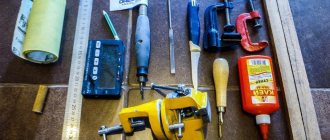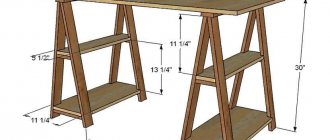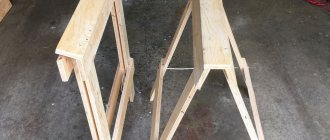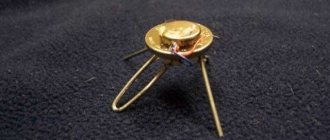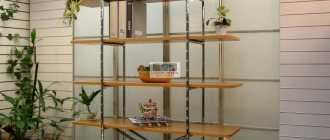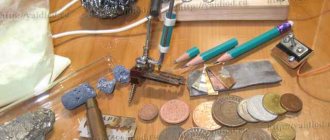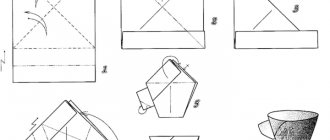06/24/201606/26/2016 master
In many modern interiors you can find such a lighting device as a salt lamp. Such a lamp, due to the certain properties of its components, has many positive qualities and will be an excellent addition to any design.
Such a lamp is quite expensive, and it is difficult to get a real device. Therefore, today craftsmen have learned to make them with their own hands at home. If you want to know how, read our master class.
Is it necessary?
Making a salt lamp with your own hands at home is quite quick, but first it is always useful to understand whether you need this item, and only then start looking for materials and tools. So what is the famous salt lamp and how does it work?
In short, this is a natural ionizer. It was originally made from Himalayan salt. It also has another name - halite. This substance is a particularly pure salt, which, moreover, contains microelements that are very necessary for the human body:
- iodine;
- iron;
- magnesium;
- potassium;
- other elements - there are more than eighty of them in total.
Important! Salt of this composition is mined only in the Himalayas, so a lamp made from it is a very expensive pleasure. The most difficult step for someone who would like to make such a lamp is to get a suitable salt crystal. But if you succeeded, then why not do it?
Benefits and harms of the device
For adults
There are only two contraindications for speleotherapy: diseases of the cardiovascular system and kidneys. The fact is that excess sodium chloride in the body creates additional stress on the heart by retaining excess fluid in the bloodstream. With regard to salt lamps, due to their small area and efficiency, these restrictions are irrelevant. A device weighing about 3 kg in a room of 25 m2 will not create a concentration of salts in the air sufficient for absorption into the bloodstream through the mucous membrane of the bronchi and alveoli of the lungs.
Children and newborns
For children, the most pronounced benefit of a salt lamp is on the respiratory system. In particular, with frequent rhinitis and sinusitis, it was noted that after installing a lamp in a child’s bedroom, children’s breathing becomes easier due to the cessation of runny noses. It is possible that the subsequent improvement in sleep and psycho-emotional background is associated with this effect. Or maybe the evaporation of magnesium sulfides has a calming effect, as a result of which the anti-stress factor leads to strengthening of the immune system.
In any case, there is not a single evidence of a negative effect from the device, although a pronounced therapeutic effect should not be expected from it. It is safe to say that a salt lamp is a natural air ionizer that reduces the activity of pathogenic microflora and has a beneficial effect on the health of children and adults.
In addition, this is a way to decorate a living area with health benefits. What is definitely not possible is to consider the lamp as a panacea, pinning hopes on it to the detriment of the main treatment prescribed by the attending physician.
Where are salt lamps used?
Since the ions that are released when heated purify the air and enter the human body through the respiratory tract, this device is more of a medical device than a household one. It is widely used in speleotherapy - treatment in caves.
Important! Such a device cannot be the main lamp in the room - it gives too dim and subdued light. But as additional lighting designed to draw attention to a certain corner in your room - why not?
How to spot a fake
Now there are a large number of different salt lamps, among which, unfortunately, there are often fakes.
You can identify such a product based on several criteria:
- If the manufacturer has not provided for the return of the device, it is likely that it does not meet the specified parameters.
- Natural salt utensils are quite fragile. Therefore, if the design appears to be very durable, it is a fake.
- Too bright light also indicates that the crystals are unnatural.
- The location must be indicated on the packaging.
- When approaching water, the natural lamp fogs up.
- Too low a price also indicates that the design is unnatural.
It is not recommended to purchase a fake, since it will not only not have the necessary effect, but may cause harm.
Let's understand the device
A DIY salt lamp is made from three main elements:
- salt crystal;
- the actual lamps;
- grounds.
salt crystal
Pink Himalayan salt is an amazing combination of beauty and benefits. Lamps made by craftsmen who are fluent in their ancient craft come in the most bizarre shapes. This is not a whim of the designer, but a necessity. The fact is that during manufacturing it is very important not to destroy two things:
- crystal structure;
- its natural form.
Why is this so important? If one or the other is violated, the lamp loses part of its properties as a natural ionizer. Ions, of course, are released, but the efficiency decreases.
Interior use
The salt lamp looks discreet and at the same time stylish. When illuminated with electric light, the natural structure of halite looks noble and can decorate any room. At the same time, those lamps that the designer worked on and unshaped crystals look equally good.
According to color therapy, the beautiful, rich colors of the mineral also have a positive effect on humans:
- white is the color of purification, healing;
- pink - makes a person more emotional;
- yellow - increases intelligence and intelligence, has a beneficial effect on the liver, pancreas and gall bladder;
- orange - helps fight stress, creates a sense of security, is good for the kidneys and bladder;
- red - strengthens the heart and stimulates blood circulation, activates vitality.
A salt lamp made with your own hands can become both a home decoration and an assistant in maintaining the health of family members.
This is interesting: How to properly create lighting for stairs - we outline it in detail
Classic version
Did you manage to get a crystal of the right size? Fabulous! You can think about other elements as well. It won’t be difficult to get a light bulb - it’s a very ordinary low-power incandescent lamp. Where can I get the foundation? Before you make a salt lamp with your own hands, rummage through your bins - maybe you will find a very ordinary old night light there. It will be very lucky if it still contains microcircuits and wires. If you don’t have anything similar in your household, just buy the cheapest wall lamp or table lamp in the store.
What we make it from
Stand
You can make a lamp of this type with your own hands from the following materials:
- suitable piece of salt. It can be bought in specialized stores, brought back from a trip or ordered online;
- stand. Any decoratively decorated box can act as a stand. You can also use a stand from an old lamp;
Note! You can easily make a stand for a salt lamp with your own hands from wood.
- Super glue;
- wire of the required length;
- 3 pieces of rubber.
Tools you will need:
- hand drill with a thick drill bit;
- bolts or screws;
- screwdriver;
- soldering iron
Now you can start making the lighting fixture itself.
Salt lampshade
A classic lamp is an ideal option. And the lamp heats it well, and it does not pose any danger. It has only one drawback - the light turns out to be very dim.
If you want to go a little brighter, try designing a lamp with an open shade. There is no point in wasting precious pink salt on this, but such a structure can be built even from the most ordinary table salt with a minimum amount of impurities. The main thing is that it is in the form of a crystal and does not crumble (sometimes you can buy one even in the most ordinary hypermarket).
Preparing the crystal
In essence, a salt lamp can be thought of as something like a cap, like a chandelier, only it is made from a single crystal of salt. This is what you have to create:
- Examine the crystal.
- Determine the side that most resembles the bottom.
- Compare it with the future foundation.
- Mark the locations for the holes for the screws.
Making a lampshade
It is more convenient to make the salt lamp so that you do not have to unscrew it if you need to change the light bulb. That is, it will need to be very carefully drilled out from the side of the light bulb so that the bottom remains intact for now. An electric drill is unlikely to help in this case; it is better to drill by hand. However, halite, and even more so ordinary table salt, is still not a diamond, it drills well, and it is important to make sure that nothing unnecessary falls off.
Important! The hole should not be too large – the light bulb should be able to screw into it freely, but that’s all. You can leave small gaps between the light bulb and the walls of the crystal. The air will still heat up, and ions will enter the room.
We put it on the stand
How will the light bulb be inserted into your lamp? It has a base, which, in turn, is screwed into the cartridge:
- Mark and drill a hole for the cartridge - it should fit tightly.
- Drill holes for self-tapping screws - in the base and in the crystal or only in the crystal from the bottom.
- Fill the holes with glue.
- Screw on the stand.
Important! It is very good if you can drill the crystal so that you can use the existing holes in the base - in this case, you should use them.
Screw in the light bulb
Anyone can screw the lamp into the socket. But you need to know which one exactly. Regardless of which lamp option you choose, the light bulb should be low-power. 20 W is quite enough.
The question arises, what kind of lamps are suitable for this? It hardly makes sense to use LED ionizers; they practically do not heat up. But if you are just making an original lamp, without any healing effect, then why not? The beauty of LEDs is that they are small and multi-colored, so you can make a very original trinket.
Incandescent lamps are best suited for the ionizer. They heat up beautifully, which is exactly what you want.
LiveInternetLiveInternet
—Tags
—Categories
- knitting (4189)
- sweet life (3572)
- to the delight of meat eaters (3114)
- sore point (2683)
- amazing baked goods (2433)
- I will be better. (2257)
- let's have a snack (2179)
- let's hit the vegetables (1610)
- cellar (1470)
- tips for life (1274)
- not a day without salad (1138)
- fish day (861)
- unusual dessert (839)
- outdoors, in the garden and vegetable garden. (803)
- poetry of colors (801)
- sewing and cutting (646)
- holiday (562)
- I will lose weight 100% (494)
- alluring world of flowers (486)
- handmade (426)
- what's first? (408)
- the pain of the soul flowed onto the paper (381)
- music inside us (319)
- interesting story (287)
- wine cellar (282)
- please speak (261)
- we fast tasty, satisfyingly, with pleasure (183)
- interior (182)
- books, films (182)
- PunchMorsCocktail (154)
- like an echo of days long gone (photo) (121)
- bread is the head of everything (113)
- pizzeria at home (112)
- tea break (80)
- coffee aromas (79)
- a thought appeared (77)
- cooking from. from appetizer to dessert (62)
- we teach ourselves (34)
- in palms - crumbs (24)
- computer help (5)
Where to put the salt lamp?
The placement depends on what you did it for. Such a device can decorate any room:
- living room;
- bedroom;
- nursery;
- kitchen;
- corridor.
Perhaps the only place where you should not place either a healing or a decorative lamp is the bathroom. The humidity there is too high, and salt tends to dissolve in water. If you need an ionizer, choose the room where it is most needed. Most often this is the bedroom or living room.
Important! Feng Shui fans most often place such things in bedrooms. It is believed that negative energy disappears, and positive energy accumulates. There is one more subtlety. Typically, electrical appliances are placed quite far from each other. Here we must do exactly the opposite. A salt lamp will work more effectively next to a TV, computer or microwave.
What about harm and contraindications
There are also no contraindications for using salt lamps. They can be kept on for a day, and even for a whole week - after all, air ionization cannot occur with their help. These are the physical properties of sodium chloride, and the manufacturer of this device cannot do anything about it, even if they want to.
Important! About treating allergies with salt: You won’t find salt tablets or salt solutions for allergic reactions in any pharmacy. But they are not there for one simple reason - they do not have any effect on this disease. The only way to harm your health using a salt lamp is to eat the crystal lampshade of this device in one sitting.
The only way to harm your health using a salt lamp is to eat the crystal lampshade of this device in one sitting.
Everyone can choose for themselves whether or not to use this device. Although it is worth listening to the opinion of experts and not placing much hope on a salt lamp. It’s better to go to the sea once a year and breathe in the salty and healing sea air. Good health to you!
What else can such a lamp do?
A salt lamp can do a lot! Of course, it helps to improve well-being, including in some serious diseases:
- neuroses;
- hypertension;
- rhinitis;
- bronchitis;
- tracheitis;
- furunculosis.
Of course, the healing effect is provided by a lamp made from genuine Himalayan salt, and not substitutes. But such a lamp also has several other functions that it copes with brilliantly, and it does not matter what kind of salt it is made of:
- The humidity in the room is stabilized - any salt absorbs water.
- Eliminates unpleasant odors.
Principle of operation
The action scheme can be described as follows:
- When heated, the lamp acts on the salt that surrounds it.
- Salt releases negative ions into the air.
- The air in the room where the device operates is purified. During operation, salt crystals heat up. Upon contact with air molecules, an interaction occurs - a reaction. As a result, positive sodium ions are neutralized and released into the surrounding air. In addition to this, purification occurs due to a large number of cycles of conversion of hydrogen and oxygen, released by chlorine and sodium ions.
Any salt contains many useful substances that, when heated, enter the air. If you use special additives or sea salt in production, the benefits will be even greater. Regardless of what source material it is made from, a salt lamp has no equal in terms of benefits for the body.
How long does the lamp last?
A salt lamp is completely harmless to humans, unless one of the inhabitants of the apartment has an individual intolerance to one of the elements. It can burn around the clock. As for the service life, it entirely depends on how long the base, that is, the light bulb, microcircuits and cord, will work. But if desired, the base can be replaced - or some of its elements can be repaired.
But what harms a salt lamp is excess humidity. Salt absorbs water and the lampshade may begin to lose its shape. If this happens, do the following:
- Turn off the device.
- Wipe it with a dry cloth (microfiber is best).
- Place in a warm and dry place for a while.
Important! Do not turn on the lamp until it is dry. Moisture is dangerous for electrical appliances, for humans, and for salt. When a wire is broken somewhere, you may get an electric shock. If the wire is in order, but the lampshade is not dry, stains will certainly appear on it. They can be sanded off.
Precautionary measures
Too humid air will cause the ceiling to simply crack, and white salt deposits will come out. For this reason, you should not take the lamp into the bath or winter garden.
It is not recommended to turn it on immediately after purchase. First you need to dry the device properly in a warm place for at least a day, and then use it.
If deposits appear on the surface, they must be sanded off with sandpaper. The crystal is then wiped with a dry cloth and it is ready for use again.
It is also important to take into account that the lamp must be transported carefully so as not to damage it. When replacing a light bulb, it is necessary to disconnect the product from the power supply and the power of the replacement element should not exceed the parameters of the previous one. Otherwise, the product may simply crack, unable to withstand the load.
Otherwise, the product may simply crack, unable to withstand the load.
Imitation
If you don’t have a piece of rock salt, but you really want to make a lamp that at least looks like salt, that’s okay. You need:
- glass jar;
- salt;
- Super glue;
- lamp;
- stand.
Next we proceed as follows to make a salt lamp with our own hands:
- Coat the outside of the jar with glue.
- Roll it in salt.
- We fix it on the stand in any convenient way.
Important! You can turn any lamp with a glass lampshade into a salt lamp in exactly the same way as a jar.
Description of popular brands
- To make Stay Gold devices, special crystalline rock salt is used. These stones are mined from a depth of 0.8 kilometers in the Himalayas, in Pakistani territory. Then the minerals undergo manual processing using special methods to ensure the preservation of their natural form and crystalline structure. Therefore, each Stay Gold lamp is unique. A one-month warranty is provided.
- Ergopower Skala is a popular manufacturer of salt lamps. The devices are made from natural salt crystals. Due to the affordable price and attractive design, the products of this manufacturer are in wide demand.
- Wonder Life are attractive decorative night lights that will not only suit any interior, but will also decorate it effectively. The energy consumption of salt lamps is low, since they have built-in incandescent lamps with a power of up to 25 W.
Himalayan salt has a soft, warm hue that provides a pleasant glow. Therefore, such salt lamps are used as night lights for small children, because the weak light will not wake them up or scare them. These devices are harmless to use, so you can use them as much as you want.
Previous SaltBeautiful DIY salt lamp
Thank you, it helped!1 Didn’t help
Basic information
A salt lamp is a device that uses a regular light bulb and a salt mineral. It is like a lampshade, and its stand is made of wood. You can get acquainted with its appearance by looking at photos of salt lamps on the Internet.
The beneficial properties of mineral salts were noted after the Great Patriotic War. Scientists have found that people hiding in mineral caves have a noticeably higher level of health than others. A number of studies have confirmed positive changes in the human body.
In this regard, the idea arose to make salt devices so that people could carry out useful procedures at home. Many people note an increase in energy, and it is much easier to breathe in a house where a salt-type lighting lamp is turned on.
Myth No. 3 - Healing ions
If you dig much deeper, you will find that the therapeutic effect of negative ions has not yet been scientifically proven. Even if the salt lamp emitted them.
In the West, studies were carried out in which groups of experimental participants were placed in different rooms - with ordinary air and highly ionized air.
And none of the studies showed a significant difference in changes in patient health.
If this were really scientifically proven, then such information indicating all the proofs would be present in the documentation for any sources of negative ions.
Imagine how much this would boost device sales! Who will deliberately hush up this factor, which can be used to shut the mouths of all skeptics?
Waterproofing
How to build a salt room? When waterproofing walls, special building mixtures that have these characteristics are used. In stores that specialize in selling this group of products, consultants can easily help you find the appropriate composition. In modern construction, such products are in demand, so finding the right mixture is not difficult.
To apply the insulating composition to the wall, it must be diluted with water to form a thick paint. Then, using a wide brush, apply successively to the wall. It is better to start from the top, gradually lowering to the floor. Thus, the thickness of the insulating layer applied in this way should be about two millimeters. With such a small consumption, there is no need to purchase a large amount of the mixture. Complete hardening of the waterproofing layer will occur in a week. After this, work can continue.
Myth #4 – Himalayan salt
Regarding the salt itself. All manufacturers assure us that their lamp is made not from ordinary salt, but from Himalayan salt from Pakistan, which is more than 250 million years old.
Legend has it that these deposits were discovered thanks to Alexander the Great, whose horse at a rest began to actively lick strange red stones.
Himalayan salt contains a lot of useful minerals, which you begin to come into contact with at home through a lamp.
In the vast majority of cases, you are being deceived. To give the usual Himalayan pink hue, a piece of salt from Sol Iletsk or other places is simply tinted with potassium permanganate or other dyes.
The density of such crystals is not at all the same as that of the Himalayan crystals. If such a lamp takes in too much moisture, then it will “leak” in the future.
The original will never leak. Unless, of course, you constantly keep it in a humid room and switched off.
When the light bulb is lit, the heat from it will repel moisture, allowing the lampshade to remain dry.
